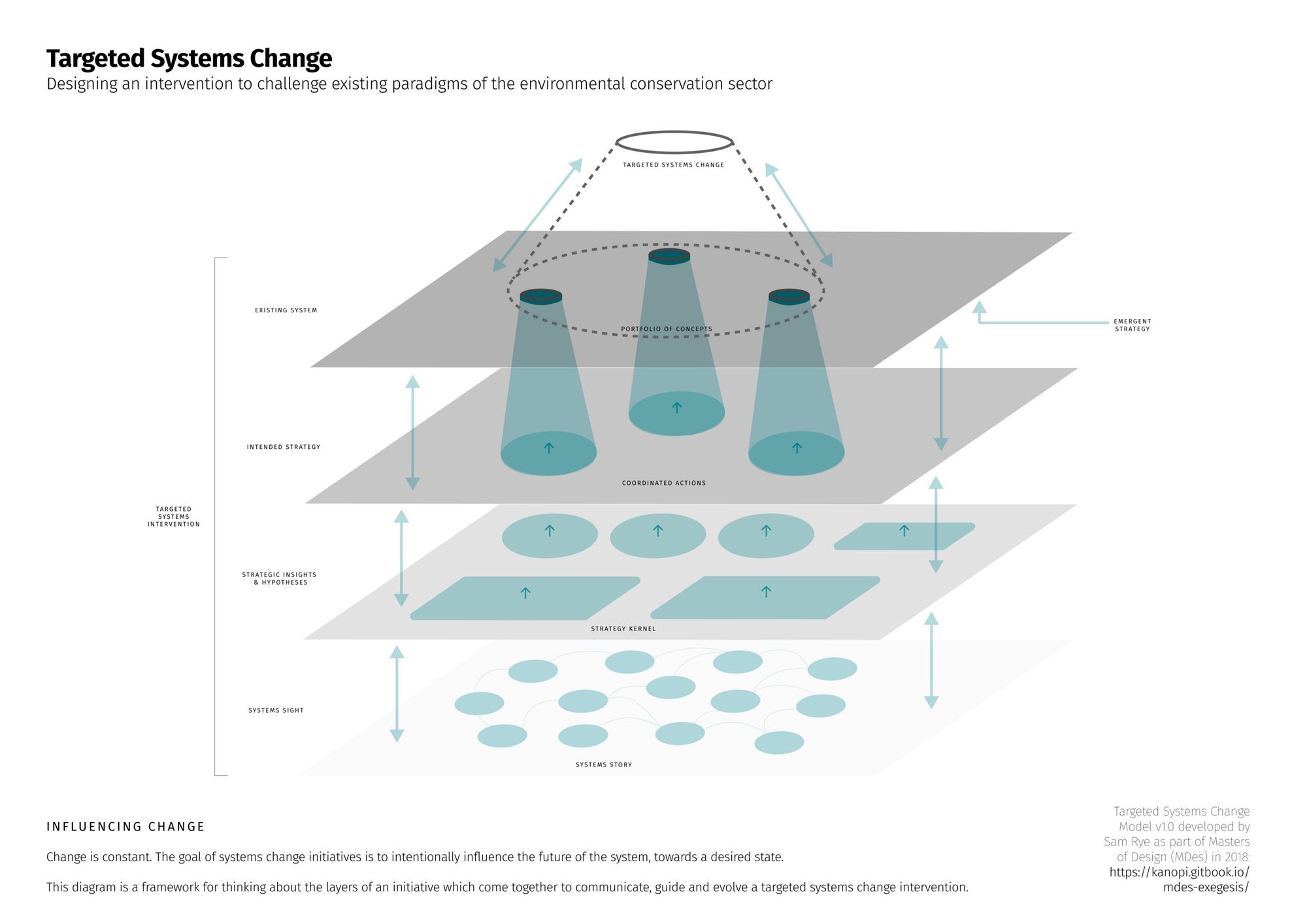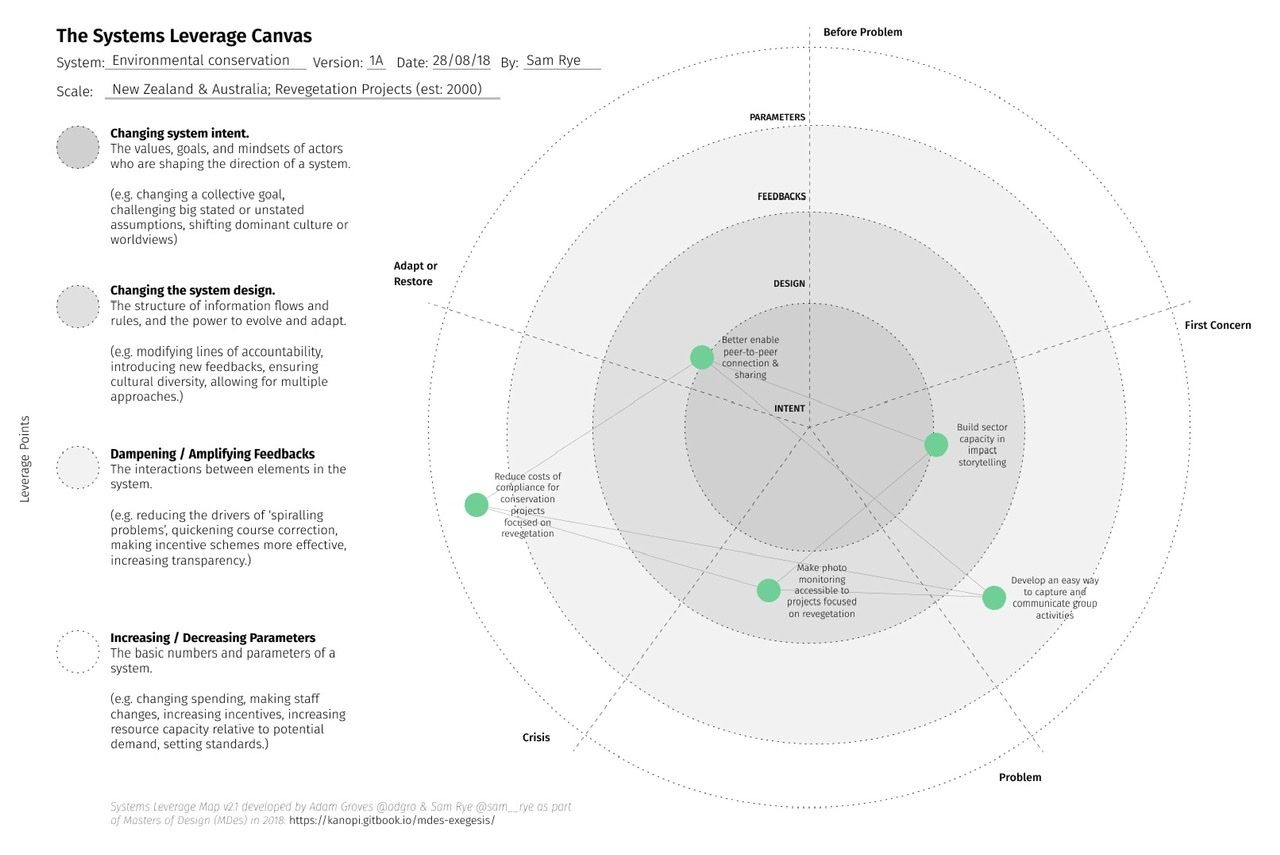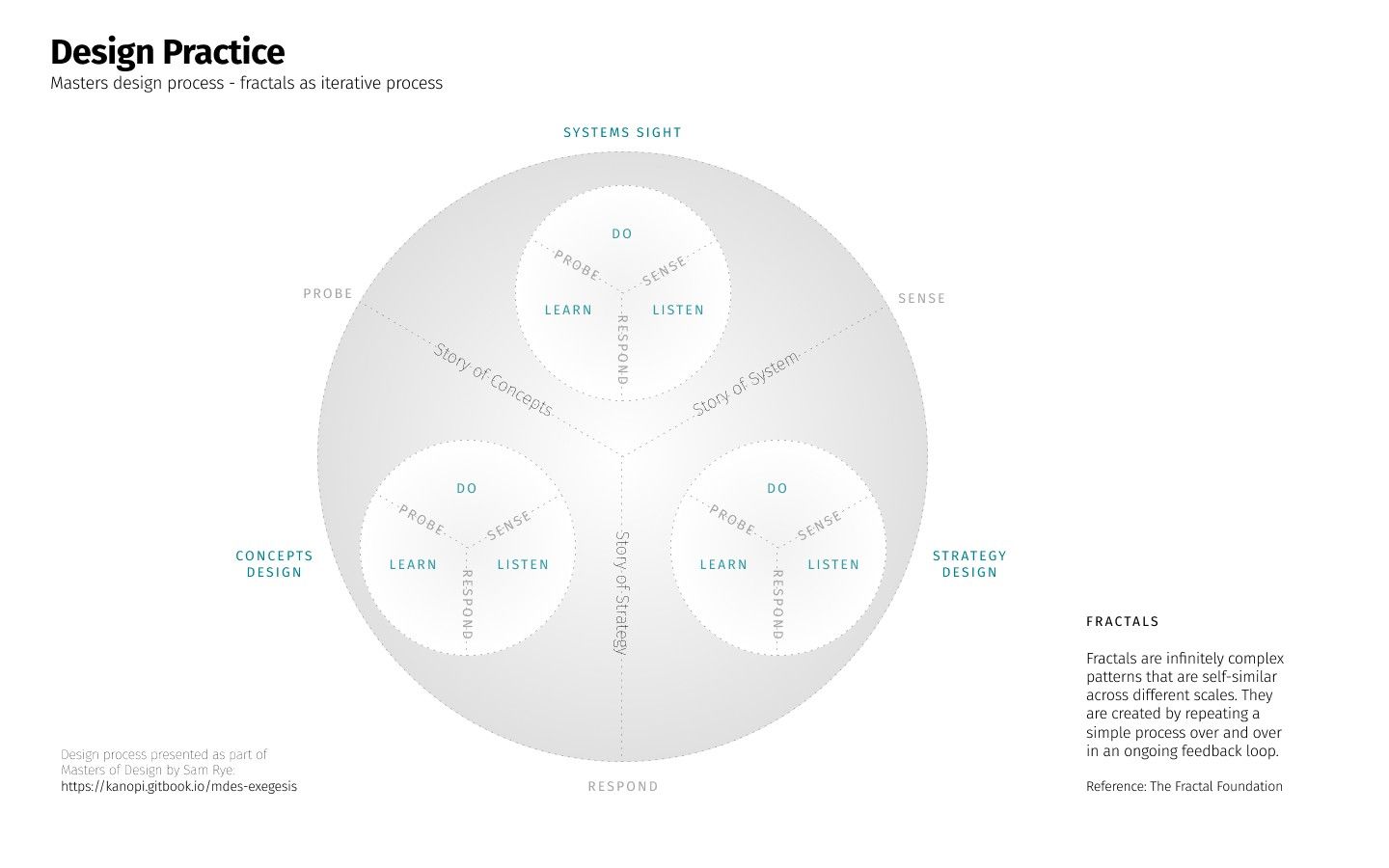Towards Targeted Systems Change

Modelling and communicating how to shift systems
As I’ve written about in the recent past, I focused my recently completed Masters of Design focused on a domain I’m particularly passionate about — environmental issues.
This post aims to uncover some of the research, thinking and framing of systems change and systemic action, from my Masters Thesis. I share the model I worked with to communicate my systems change initiatives.
If you’re interested in a spot of reading, you can read the entirety here: https://kanopi.gitbook.io/mdes-exegesis/
TL;DR
- Communicating the research, synthesis, strategy + execution for systems change is difficult but necessary. I present a model for doing that.
- I share how I blended systems analysis, strategy and prototyping, to develop a portfolio of prototypes which make up a systems change initiative.
- I share some insights about alternative approaches to developing, scaling and coordinating systems interventions, which may be more effective at increasing the likelihood of reaching a desired state.
A Model for Targeted Systems Change
I developed this model as part of my Masters of Design, in order to communicate my design process, and to give shape to the sometimes slippery concept of systems change work which may be about culture, relationships and products/services.
My starting point was inspired by an illustration of Transition Theory, presented in Finance Innovation Lab’s ‘A Strategy For Systems Change’ Report [1], which shows how three interconnected strategies come together to catalyse systems change.
The model I presented, looks like this:

In this model, I present my perspectives about the foundational stacks needed when we design a targeted systems change intervention:
- Systems Sight — an analysis of the existing system, communicated as a map and story.
- Strategic Insights & Hypotheses — a diagnosis and direction for action.
- Portfolio of Prototypes — an array of interventions which give form to the strategic action.
Together, these come together to create the targeted systems intervention, which must also be aware of the wider context it’s working in.
My conceptualisation of targeted systems change interventions was built on Odin Mühlenbein’s article “Systems Change — Big or Small?” [2], which posits that there should be ‘big vision’ objectives for systems change, and smaller initiatives which focus resources towards systemic change, often coordinated tightly or loosely:
“it is much easier to develop strategies for targeted systems change than for big visions. Targeted systems change is more specific, smaller in scope, and often more closely related to ideas and networks that social entrepreneurs are already familiar with. Obviously, it’s important to keep the bigger picture in mind. But the goal is to use a targeted systems change as the focal point for an impact strategy, combined with a clear rationale how that that change promotes the big vision.”
— Odin Mühlenbein, 2018. “Systems Change — Big or Small?”, SSIR
On Systems Leverage
In addition to the model of systems change, I wanted to explore how to best articulate the important nuances of the strategy’s specific target. In doing so, I was reading Adam Groves’ piece about moving from service design to systems change [3], in which he introduced a systems leverage map, based on concepts from Donella Meadows and Simon Wardley’s work.
As part of my work to articulate the Strategy layer of the intervention, I created a v2 of the Systems Leverage Map in collaboration with Adam, which looked like this:

This map presents several useful aspects, which I think others might find valuable in their own practice:
- A way to visualise the a strategy, service or other form of intervention, in the context of systems leverage points and lifecycle of a challenge.
- A boundary artefact to engage in generative discussion and critique about the design of an intervention, with others.
- A way to visualise the discrete or interconnected nature of an intervention, but also potentially the amount of resource to be invested in each (use size to denote scale), alternative scenarios (use colour to denote alternative scenarios), or really whatever else people dream up.
I am excited by this canvas, for it’s potential to advance the crafting of systems change strategies. I would love to hear from you if it resonates, and how you might use it in your own practice.
What I feel we additionally need discussion about and ways to communicate, is the breadth (what percentage of the system?) and depth (what kind of impact, and how deep and lasting is the change?) of systems change strategies. We need to be more explicit about what scale we want to act at, and what degree of change we aspire to.
Crafting a Systemic Intervention
In formulating my final written part of my Masters, I explored how to share the non-linear nature of my design practice. What I ended up sharing was this simple visual:

What I found, was that as I developed systems sight, I would bridge those insights into elements of strategy or concept design, project those back into the systems analysis, and continue in this vein throughout the project. This non-linearity is a vital part of working in complexity due to the nature of emergent outcomes.
“No man ever steps in the same river twice, for it’s not the same river and he’s not the same man.”
- Heraclitus, Greek Philosopher
To this end, as I mentioned in the description of the model, I feel that the stacks of systems analysis, strategy and prototype portfolio are a minimum-viable architecture to design a systems intervention. Yet it’s the weaving together of these, and the ability to zoom in and out, and evaluate and evolve that is the art of creating an intervention that is likely to succeed. As Dan Hill notes in ‘Dark Matter and Trojan Horses’ [4]— zooming from the meta to the matter is a core competency of strategic designers. We need to give form to ideas which may evolve into something much bigger (such as a workshop resource which introduces a new culture of working together), but also be able to play in the dark matter (such as navigating power and relationships) that makes up systems.
On Scaling Impact
Finally, I’d like to offer some thoughts about systems change and impact, based on the insights from closely attuning my work with cutting edge research about complexity and its implications for how we approach complex challenges.
There’s a common theory of change which seems to have swept across the social sector, but the problem is — it rarely works as intended.
The idea is that we try something, often as a Pilot, and then if it works, we scale it up. Yet, all too often the ‘scaled up’ version doesn’t have the same effect as the pilot. Why is this? In a word: complexity.
Complexity denotes that you can do exactly the same thing, to exactly the same part of the systems, and you can get a different result. Causality is not fixed. Emergence is a dominant characteristic of living systems.
I know I’m not saying anything new about Pilots — people have been saying this for awhile…
Heart of the Heart - Doomed to Failure: http://www.heartoftheart.org/?p=2619
Alternative Approaches To Scaling
Well, if we’re not going to ‘scale up’ a pilot that has worked, what could we do instead? How could we have the scale of impact which we need, given the size of the challenges which face us locally and globally, today?
Here’s three alternative models which I am interested in exploring further, borrowed from ecological approaches to replication:
- Swarm. Much of the effort that goes into scaling efforts is about centralising the coordination, monitoring or otherwise. What we’ve learnt about swarm behaviour in nature, is that it relies on self-organised, collective behaviour. There are some examples around the world of decentralised movements and causes, but more experiments are needed in how to better use this approach for systems change.
- Replicate + Adapt. The driving force of evolution is the constant cycle of replication and adaptation. Incentivising this approach for systems change activities could avoid the need for scaling up individual efforts, by significant replication of the core of an intervention, which is then localised to a specific context. For example, a funder might recognise the value in this approach, and fund a systems change initiative with explicit budget to open source the intervention (e.g. service / product blueprints and handbooks) so that others could replicate. Having taken Lifehack (our social lab on youth mental health in NZ) in this direction, I am deeply surprised this doesn’t happen more often.
- Cascade. This is a nascent thought, but I regularly see this pattern in nature whereby a species of animal or tree creates conditions for many others to live. Whether it’s a beaver dam, a tree with a large canopy, or a hermit crab, this pattern is common and has potential to be explored. I could see a role for ‘keystone’ interventions which create a sort of beach head into a system where a complex challenge (like obesity for example) may exist. These keystone interventions would explicitly be part-funded to share insights, relationships and resources which allow other, niche interventions, to get started and make a difference.
As I say, these ideas are fieldnotes — ponderings which others may find useful, that I intend to pursue in the coming years, and am keen to hear from other people about. Perhaps you know people who are already working in these ways? Perhaps you have good examples of ‘impact ecosystems’ being established with one or more of these patterns? Whatever sparks, I’d love to hear more about it.
References
[1] The Finance Innovation Lab. (2015). A Strategy for Systems Change. Page 28. London, UK. Retrieved from: https://financeinnovationlab.org/insights/strategy-systems-change/
[2] Mühlenbein, O. (2018). Systems Change — Big or Small? Stanford Social Innovation Review, February, 3–6. Retrieved from https://ssir.org/articles/entry/systems_changebig_or_small
[3] Groves, A. (2018, March). From service design to systems change. Medium, 1–8. Retrieved from https://medium.com/@adam.d.groves/from-service-design-to-systems-change-72fa62b1714c
[4] Hill, D. (2014). Dark Matter and Trojan Horses: A Strategic Design Vocabulary. Strelka Press. Retrieved from https://strelka.com/en/press/books/dark-matter-and-trojan-horses-a-strategic-design-vocabulary





